Sens. Hassan and Young Reintroduce Crucial R&D Legislation
American Innovation and Jobs Act will ensure that the tax code supports the ability of manufacturers to out-compete China and create well-paying jobs
Washington, D.C. – Following the introduction of the American Innovation and Jobs Act by Sens. Maggie Hassan (D-NH) and Todd Young (R-IN), National Association of Manufacturers Managing Vice President of Tax and Domestic Economic Policy Chris Netram released the following statement:
“Manufacturers are hiring workers, investing in communities across the United States and creating the products, materials and processes that drive America forward. Manufacturers applaud the introduction of the bipartisan American Innovation and Jobs Act, which restores full deductions for research, helping the American industry out-compete China, which provides a 200% super deduction for manufacturers’ research—20 times the amount in the U.S. tax code,” said Netram. “Manufacturers, the vast majority of which are quite small, perform 55% of private-sector research and development. These investments in innovation spur economic growth and support the creation of high-paying jobs across the country. Congress should approve the American Innovation and Jobs Act quickly to support critical research that allows manufacturers to improve lives in America and for people around the world.”
Background: As of 2022, manufacturers can no longer immediately deduct their R&D expenses in the year in which they are incurred. Instead, manufacturers must deduct or amortize their expenses over a number of years, which makes R&D much more expensive to undertake. The American Innovation and Jobs Act would restore the immediate deductibility of R&D expenses, a policy that was in place for nearly 70 years. In the 117th Congress, the American Innovation and Jobs Act garnered 35 cosponsors: 17 Democrats and 18 Republicans. A recent analysis released by the NAM finds that the industry would lose 59,392 jobs and face a decline in output of $31.69 billion this year if Congress does not act.
-NAM-
The National Association of Manufacturers is the largest manufacturing association in the United States, representing small and large manufacturers in every industrial sector and in all 50 states. Manufacturing employs nearly 13 million men and women, contributes $2.81 trillion to the U.S. economy annually and accounts for 55% of private-sector research and development. The NAM is the powerful voice of the manufacturing community and the leading advocate for a policy agenda that helps manufacturers compete in the global economy and create jobs across the United States. For more information about the NAM or to follow us on Twitter and Facebook, please visit www.nam.org.
Timmons: We Have to Get Serious About Competing with China; The President’s Budget Does the Opposite
Washington, D.C. – National Association of Manufacturers President and CEO Jay Timmons released the following statement on President Biden’s fiscal 2024 budget plan:
“There is no escaping the fact that the tax increases in President Biden’s new budget proposal would reverse the recent significant growth we’ve achieved in American manufacturing jobs and investment.
“After the 2017 tax reform made rates more competitive, manufacturers kept their promises to raise wages and invest in their communities. In fact, 2018 was the best year for manufacturing job creation in the previous 21 years. And in the past two years, as we rebuilt from the pandemic, we’ve created more jobs in the sector than at any point since the Reagan administration. So it comes as a surprise that President Biden, who has vocally championed manufacturing growth in pushing successfully for infrastructure investment and the CHIPS and Science Act, wants to pursue policies that would undo our progress.
“We have to get serious about competing with China; the president’s budget does the opposite. This proposal further undermines manufacturing in America by failing to reverse tax policies that make it more difficult for our industry to perform research, while China currently employs a 200% super deduction on R&D for manufacturing. It’s also now more expensive to buy critical machinery and finance new investments. If these lapsed deductions aren’t reinstated, it will mean lost jobs, less innovation and fewer opportunities for our communities.
“As manufacturers work to lead our economy forward, we also remain committed to lowering health care costs through market-based solutions that deliver choice and flexibility. Unfortunately, this administration’s insistence on imposing drug pricing requirements is an abdication of free market principles that poses serious risks to the development of new treatments and therapies—the very type of innovation that saves lives in America and around the world.
“Manufacturers are committed to growing investment, jobs and wages here in America. We need our government leaders to share that commitment.”
Background: Read more about how these critical tax priorities impact manufacturers across the country here.
-NAM-
The National Association of Manufacturers is the largest manufacturing association in the United States, representing small and large manufacturers in every industrial sector and in all 50 states. Manufacturing employs nearly 13 million men and women, contributes $2.81 trillion to the U.S. economy annually and accounts for 55% of private-sector research and development. The NAM is the powerful voice of the manufacturing community and the leading advocate for a policy agenda that helps manufacturers compete in the global economy and create jobs across the United States. For more information about the NAM or to follow us on Twitter and Facebook, please visit www.nam.org.
More Women Join the Manufacturing Workforce
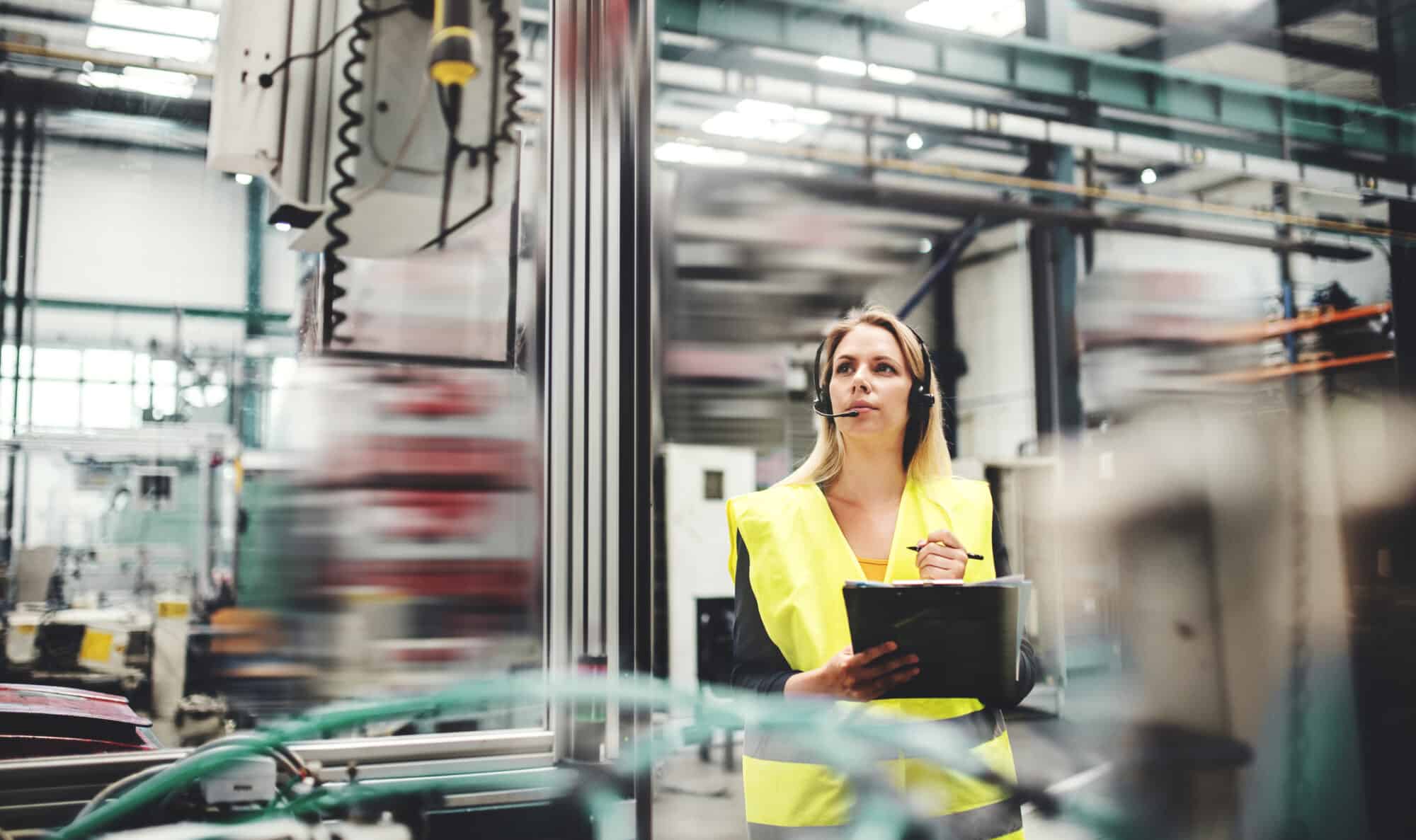
Fresh off International Women’s Day, which was March 8, there’s some encouraging news on the labor front: more women are coming back to the workforce, both in manufacturing and throughout the economy.
In manufacturing: Female employment in the industry reached its height this year, with a total of 3.77 million workers, according to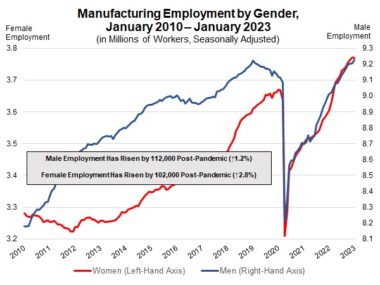 NAM calculations based on BLS numbers.
NAM calculations based on BLS numbers.
- Women now account for 29% of the manufacturing workforce.
- A year ago this week, the Manufacturing Institute, the NAM’s 501(c)3 workforce development and education partner, launched its 35×30 campaign, an initiative that aims to boost women’s share of the manufacturing workforce to 35% by 2030.
The overall economy: “Women have gained more jobs than men for four straight months, including in January’s hiring surge, pushing them to hold more than 49.8% of all nonfarm jobs,” according to The Wall Street Journal (subscription).
- “Female workers last edged higher than men on U.S. payrolls in late 2019, before the pandemic sent nearly 12 million women out of jobs, compared with 10 million men.”
Why it’s happening: The child-care disruptions and health concerns that made many women leave the workforce during the pandemic are diminishing, while employers offer historically high pay and increasing numbers of remote positions.
Why it’s important: More women in the workforce could help ease both worker shortages and inflation.
- With January unemployment reaching a 53-year low, “[a] greater supply of labor could work to counter rising wages and align with the Federal Reserve’s goal of cooling inflation,” according to the Journal.
- More job seekers could also help U.S. manufacturers, whose job openings edged up to 803,0000 in January.
The last word: “In just a year, the 35×30 campaign has made great strides in increasing the number of women in manufacturing—and the latest data show as much,” said MI President Carolyn Lee. “We’re close to our goal. Together, we can get the rest of the way there and make it to 35% by 2030.”
E-Cycling Helps Manufacturers Generate Business Value
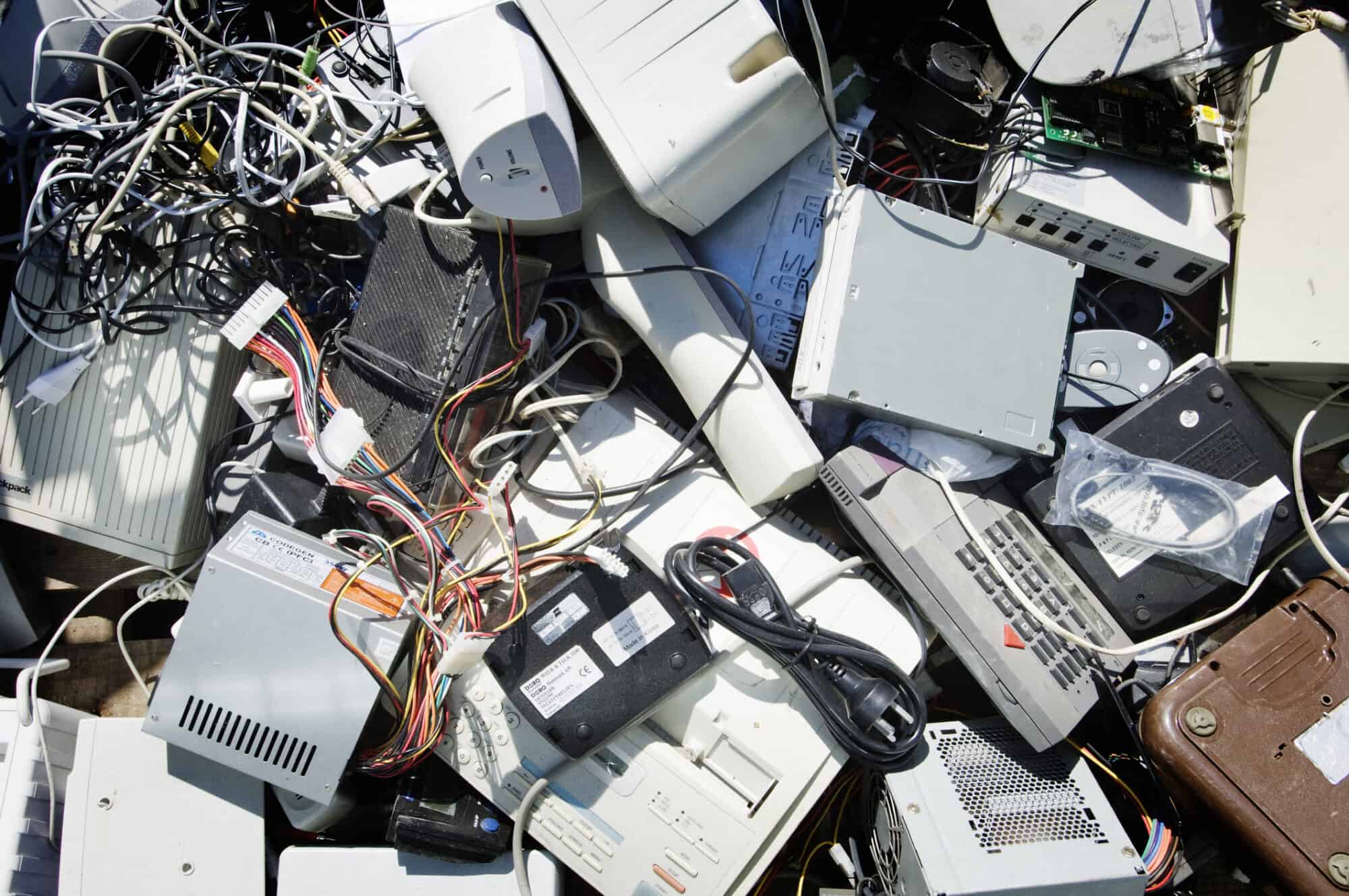
Electronic waste is a big problem.
In 2019, the world generated a record 53.6 million metric tons of discarded electronic and electrical devices, according to a Global E-waste Monitor report. That’s an increase of 21% in just five years. But there’s more: The figure is expected to double by 2050, hitting 120 million tons annually.
The good news is that manufacturers can be an active part of the solution. Though their bread and butter has typically been bringing new products to market, manufacturers are now also developing end-of-life processes for goods to mitigate environmental impact, according to Bright Machines Vice President of Industrial Solutions Adam Montoya, writing in the Manufacturing Leadership Council’s Manufacturing Leadership Journal. (The MLC is the digital transformation division of the NAM).
The challenge: complex components. Disassembling a product is not nearly as straightforward as assembling it, according to Montoya. Take a server, for example. A company might know what’s inside it based on its original configuration, but memory or processor upgrades could have changed over the course of its life.
- When a lot of change has taken place, the dismantling process is unique to each server, making it complex and difficult to automate.
The solution: intelligent disassembly. Improving the end-of-life process for electronics requires intelligent disassembly, a combination of smart technology and a different way of thinking, says Montoya. Here’s how it works:
- Automation technology that uses AI and advanced vision systems interprets the contents of a particular component and compares it against the original blueprint.
- Next, the system assesses the presence and location of components within the unit.
- It then sorts, separates and removes components so they can be reclaimed or recycled.
The bottom line: Manufacturers stand to realize many benefits from intelligent disassembly. Components with sensitive data can have machine-driven proof of destruction. Systems with usable parts can be repurposed rapidly.
- Ultimately, it’s an important way for manufacturers to collectively reduce carbon footprints and electronic waste while delivering business value, says Montoya.
For more on this topic, read Rethinking End-of-Life Technology Value in the Manufacturing Leadership Journal. And to learn more about how manufacturing leaders are undertaking digital transformations, join the MLC at its Rethink conference in Marco Island, Florida, on June 26–28.
How a Tax Change Could Set Back Cancer Treatment
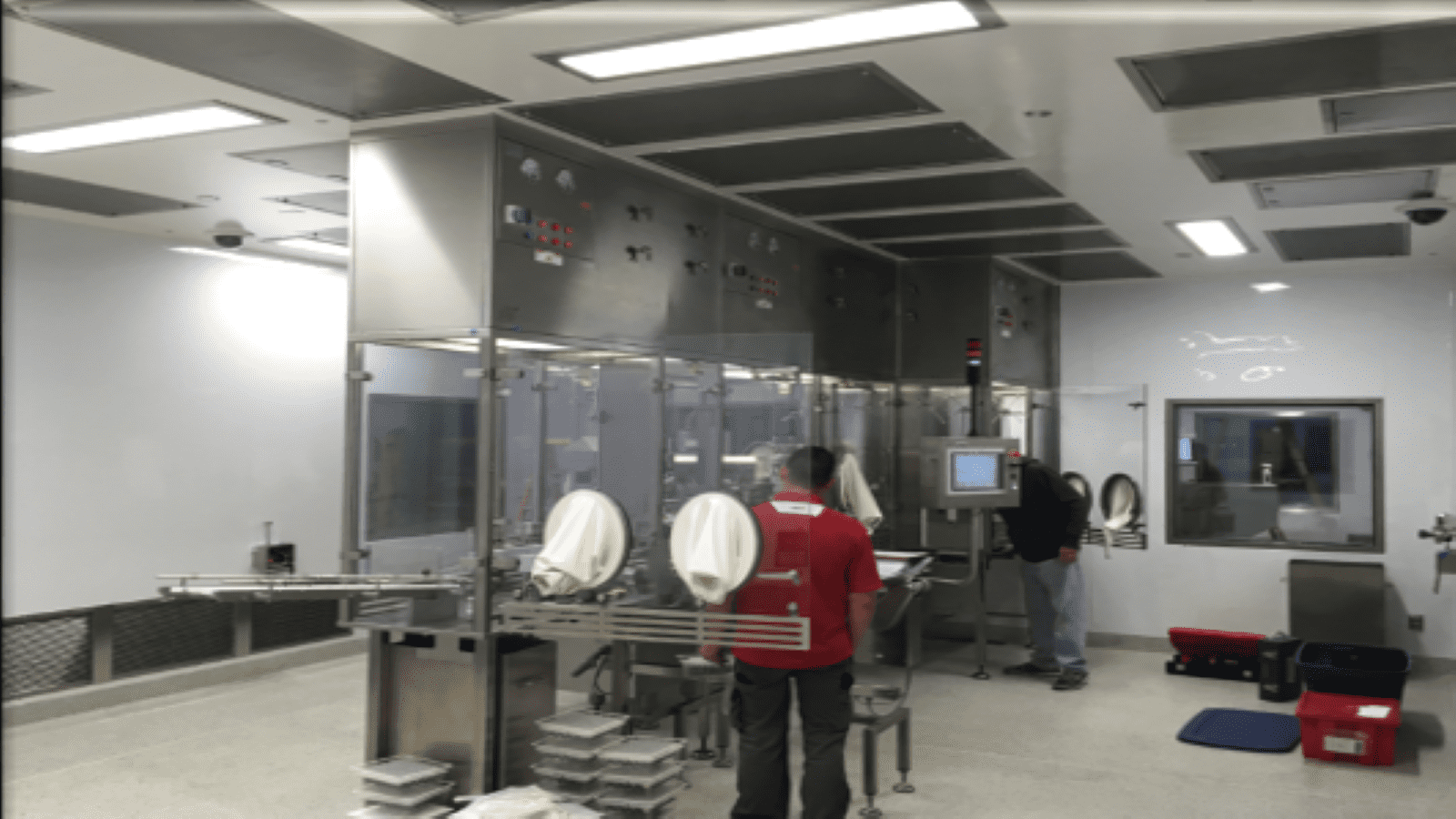
An idea becomes a prototype, then a treatment, then a lifesaver. That’s how R&D is supposed to work, but as Tolmar, Inc., can tell you, tax policy is a crucial element as well.
Tolmar spent years developing a therapy to improve the treatment of advanced prostate cancer. The resulting long-acting injectable, called ELIGARD®, works by stopping testosterone production to slow the growth of cancer cells. It’s a remarkable technology, now used by patients nationwide and around the world who are fighting advanced prostate cancer.
This innovation was facilitated by a U.S. tax policy that supported R&D investments by pharmaceutical companies. However, a recent change means that Tolmar and other pharmaceutical R&D units will find it more difficult to produce innovations that make human lives better, safer, healthier and longer.
The problem: Until about a year ago, businesses were able to deduct 100% of their R&D expenses in the year in which they incurred the expenses. Starting in 2022, however, a change in tax policy requires businesses to spread their R&D deductions out over a period of five years, making it more expensive to invest in innovation.
The cost for companies: “We have a finite amount of capital to put into the development of new products. The changes in tax policy will lead to difficult decisions,” said, Tolmar Chief Financial Officer Jeff Lederman.
- “We typically put the vast majority of our cash back into the company—whether that means investing in R&D, capital purchases or our workforce—and if we have less funding, we have to cut back in some or all of those areas. So, this policy change could have a significant impact on our organization.”
The cost to patients: This tax change could also have a negative impact on patients in the United States and around the world by delaying the development and availability of innovative new therapeutic products.
- Tolmar is one of a small number of U.S. manufacturers of long-acting injectable prostate cancer treatments, and the company has a number of other innovative medicines and therapeutics in its pipeline.
- “This is not so much about saving dollars; it’s about patient impact,” said Tolmar President and Chief Operating Officer Shawn Silvestri. “The results we’re chasing are meaningful to patients’ lives. If you’re looking for something that’s purpose-driven, that’s the kind of work we do—and that makes the choices for me that much more difficult.”
A competitive disadvantage: While the impact on patients is the most worrisome effect, the R&D tax change also has negative implications for American economic competitiveness.
- Making research more expensive puts companies that operate in the U.S., as Tolmar does, at a distinct disadvantage, especially when other countries are aggressively supporting domestic research.
Our move: At the NAM, we’re pushing Congress to reverse this change and allow manufacturers to keep investing in innovation, jobs and workers. Learn more and take action at www.nam.org/protect-innovation.
Zelenskyy to Manufacturers: We Will Prove That Democracy Is Stronger Than Tyranny
Timmons: America, and the American business community, stands with Ukraine today, tomorrow, through the end of the war
Boca Raton, FL – This morning, Ukrainian President Volodymyr Zelenskyy delivered remarks to the National Association of Manufacturers Board of Directors.

To view the address and a transcript of the remarks, click HERE.
Key Excerpts:
Voldodymyr Zelenskyy, President of Ukraine:
But what will our joint victory mean? This is not a purely ideological battle. Yes, we will prove that democracy is stronger than tyranny. When Russia loses, we will prove that terrorist states cannot overcome the power of a united democratic world.
…..
The American business [community] has every opportunity to take on leadership positions both in the reconstruction of the Ukrainian economy and infrastructure, and in demonstrating to the world that human nature should serve worthy goals and that it produces, and will always produce, the best result.
……
All these are not just investment opportunities, not just industries and not just growth. This is a wide space for victories—your victories, American business. And I urge you to prepare for these victories now, to come to Ukraine now so that by the time we restore peace, your hard work has already yielded results. And I believe that it will be soon. Thank you for your attention. I invite all of you to Ukraine. Glory to our brave soldiers. Glory to Ukraine.
Jay Timmons, President and CEO, National Association of Manufacturers:
Ukraine’s fight is our fight because this is far more than a war between two countries. It is a battle between freedom and tyranny. So America, and the American business community, stands with Ukraine today, tomorrow, through the end of the war and as Ukrainians rebuild their country after Russia is defeated.
….
We reaffirm our support for the “sanctions implemented against Russia” and for Ukraine’s “fight to preserve freedom and independence.” And we reaffirm our “commitment … to safeguarding democracy and democratic institutions not only here at home, but also abroad.”
…..
Manufacturers in America will continue to stand with Ukraine, and we will be there after Russia is defeated so that we can help you and your people build a stronger nation forever rooted in our shared democratic values.
BACKGROUND: The NAM has been an active and vocal supporter of Ukraine’s fight to defend democracy. More information on these efforts can be found below:
- NAM State of Manufacturing address, opening comments on Russia’s brutal invasion of Ukraine (Feb. 21, 2023)
- Timmons: Biden’s Visit Shows the World That the U.S. Stands with the Ukrainian People (Feb. 20, 2023)
- Manufacturers Support Aid for Eastern Europe (Jan. 26, 2023)
- Manufacturers in the U.S. Stand with Ukraine, Memorandum of Understanding between the NAM and the Ukrainian League of Industrialists and Entrepreneurs (Jan. 25 2023)
- Manufacturers Lead with Their Hearts in Ukraine Aid (March 23, 2022)
- Manufacturers United in Support of Ukrainian People, NAM Board of Directors’ unanimous resolution denouncing Russia’s aggression (March 8, 2022)
-NAM-
The National Association of Manufacturers is the largest manufacturing association in the United States, representing small and large manufacturers in every industrial sector and in all 50 states. Manufacturing employs nearly 13 million men and women, contributes $2.81 trillion to the U.S. economy annually and accounts for 55% of private-sector research and development. The NAM is the powerful voice of the manufacturing community and the leading advocate for a policy agenda that helps manufacturers compete in the global economy and create jobs across the United States. For more information about the NAM or to follow us on Twitter and Facebook, please visit www.nam.org.
NAM Honors Snap-on CEO Nick Pinchuk for Extraordinary Commitment to Manufacturing in America
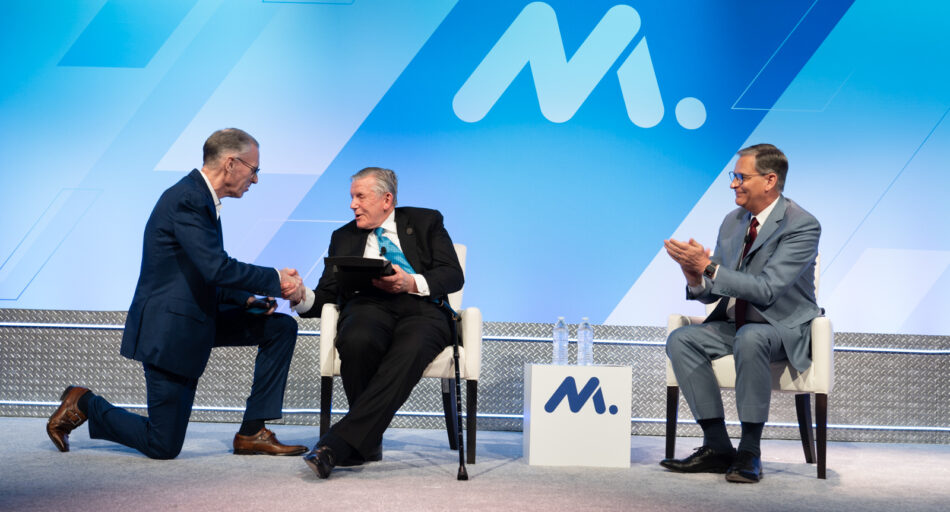
Boca Raton, FL—The National Association of Manufacturers today honored NAM board member and Snap-on Chairman and CEO Nick Pinchuk with the Manufacturing Icon Award during the NAM’s spring board meeting in Boca Raton, Florida. The award recognizes leaders who inspire Americans to promote, perpetuate and preserve manufacturing in America.
“Across the industry and across the business community, executives and employees alike look up to Nick Pinchuk. His storied career is a source of inspiration, and he is a wealth of knowledge, a wise counselor and a tireless advocate for the rewarding careers found in modern manufacturing. He has been a tremendous supporter of the NAM and the Manufacturing Institute’s Creators Wanted campaign to build the manufacturing workforce of today and tomorrow, and his policy advocacy on behalf of the industry is best-in-class,” said NAM President and CEO Jay Timmons.
“His presence on television and in the public eye as a principled manufacturing leader, as well as his unwavering service to the NAM and to our industry, makes Nick a true model for business leaders in America. In whatever he does, he demonstrates an unshakeable commitment to the values that have made our country exceptional and keep manufacturing strong: free enterprise, competitiveness, individual liberty and equal opportunity. We’re honored to present this award to Nick in recognition of his outstanding leadership.”
Pinchuk serves on the NAM Executive Committee as the NAM tax, domestic economic and regulatory reform policy vice chair and on the board of directors of the Manufacturing Institute, the workforce development and education partner of the NAM.
-NAM-
The National Association of Manufacturers is the largest manufacturing association in the United States, representing small and large manufacturers in every industrial sector and in all 50 states. Manufacturing employs more than 13 million men and women, contributes $2.81 trillion to the U.S. economy annually and accounts for 55% of private-sector research and development. The NAM is the powerful voice of the manufacturing community and the leading advocate for a policy agenda that helps manufacturers compete in the global economy and create jobs across the United States. For more information about the NAM or to follow us on Twitter and Facebook, please visit www.nam.org.
Timmons to Congress: Permitting Reform Urgently Needed
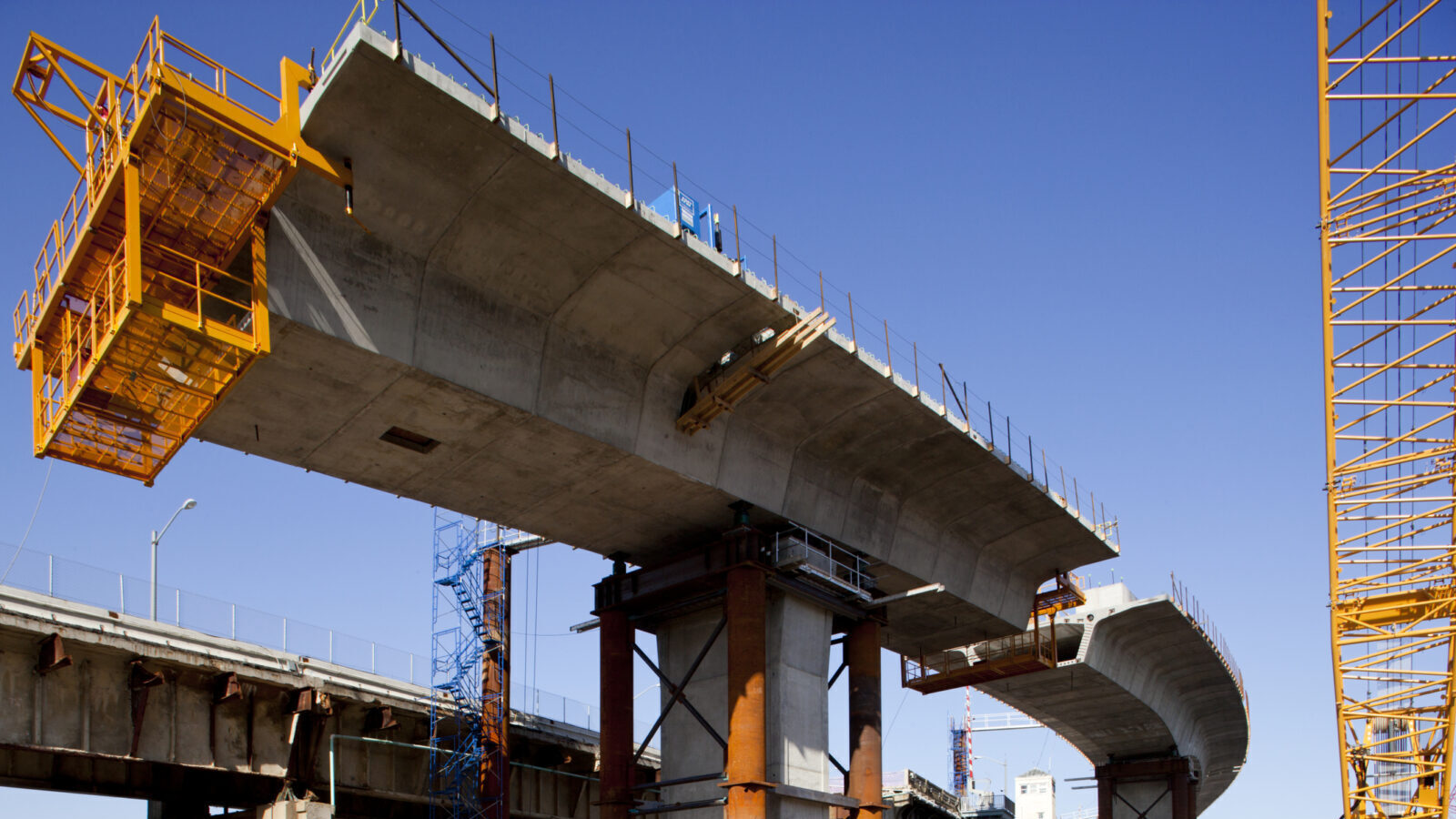
NAM President and CEO Jay Timmons has been making the most of his time on the road during the Competing to Win Tour, delivering a strong message to congressional leaders about top manufacturing priorities. He did so again yesterday on permitting reform with congressional leaders in Washington:
- “Some of the biggest obstacles preventing manufacturers—and therefore the entire American economy—from reaching our full potential are the permitting delays, red tape and complicated bureaucracy that have plagued us for decades,” he told the leadership of several House committees.
He went on to cite a number of different areas in which permitting reform is desperately needed, including . . .
Energy: Permitting reform is crucial to almost every sector of energy manufacturing, from oil and gas all the way to nuclear and clean energy technologies.
- “For example,” Timmons noted, “the siting of and infrastructure for hydrogen power generation and transportation and for advanced, small modular and micro-nuclear reactors have progressed far too slowly.”
- “Manufacturers depend on access to reliable and affordable energy to expand, which is why we support reforms that would foster transparent, streamlined and timely federal regulatory processes for the siting, permitting and licensing of energy delivery infrastructure of all types,” he continued.
Transportation: Manufacturers also need railroads, highways, airports and ports to run their operations and get their products out the door.
- “Yet obtaining permit approvals for these projects often takes years, especially when reviews are piecemeal and duplicative,” Timmons pointed out. “[M]any companies are waiting on the sidelines because transportation infrastructure construction moves too slowly—or not at all.”
- “To ensure the broad and beneficial impact of [the bipartisan Infrastructure Investment and Jobs Act of 2021] … it is critical to clear permit backlogs and ease processing timelines,” he said.
Resource development: Manufacturers prioritize sustainability, Timmons noted, but “restricting access to America’s abundant natural resources hinders our ability to strengthen domestic supply chains.”
- “The inconsistent administration of critical mineral policies, for example, has limited our ability to use a wide range of resources that lie on and beneath federal lands—resources that are critical to producing everything from cars to medical devices,” he added.
- “Streamlining resource permitting and leasing policies will help stabilize manufacturing supply chains, control costs for consumers, reduce our reliance on foreign countries and create jobs in the U.S.”
Environmental standards: Manufacturers have worked steadily to improve U.S. air quality, helping to “lead our country to the cleanest air in the modern world,” said Timmons.
- “Unfortunately, when federal agencies continually revise standards before current standards are met and before states have implemented prior mandates, they create unpredictability”—which may mean that new manufacturing facilities get built in other countries instead, where they don’t face as rigorous standards.
- However, if Congress makes regulations more predictable and consolidates review processes, the U.S. “can continue to build on its strong record of environmental stewardship by boosting domestic manufacturing, which is environmentally cleaner than international competitors,” Timmons concluded.
Congressional intent: Congress should make sure that permitting reform isn’t just passed, but also implemented as easily as possible, Timmons advocated.
- It should conform to “on recent and future statutory streamlining efforts such as One Federal Decision,” while making sure federal agencies don’t duplicate each other’s efforts and waste time.
The last word: “Permitting affects every aspect of our lives—from our economic security to our national security,” said Timmons. “[I]f we seize this opportunity to lead, there is no limit to what manufacturers in the United States can accomplish—for the good of our people and for the good of the world.”
Timmons Gives NAM State of Manufacturing Address
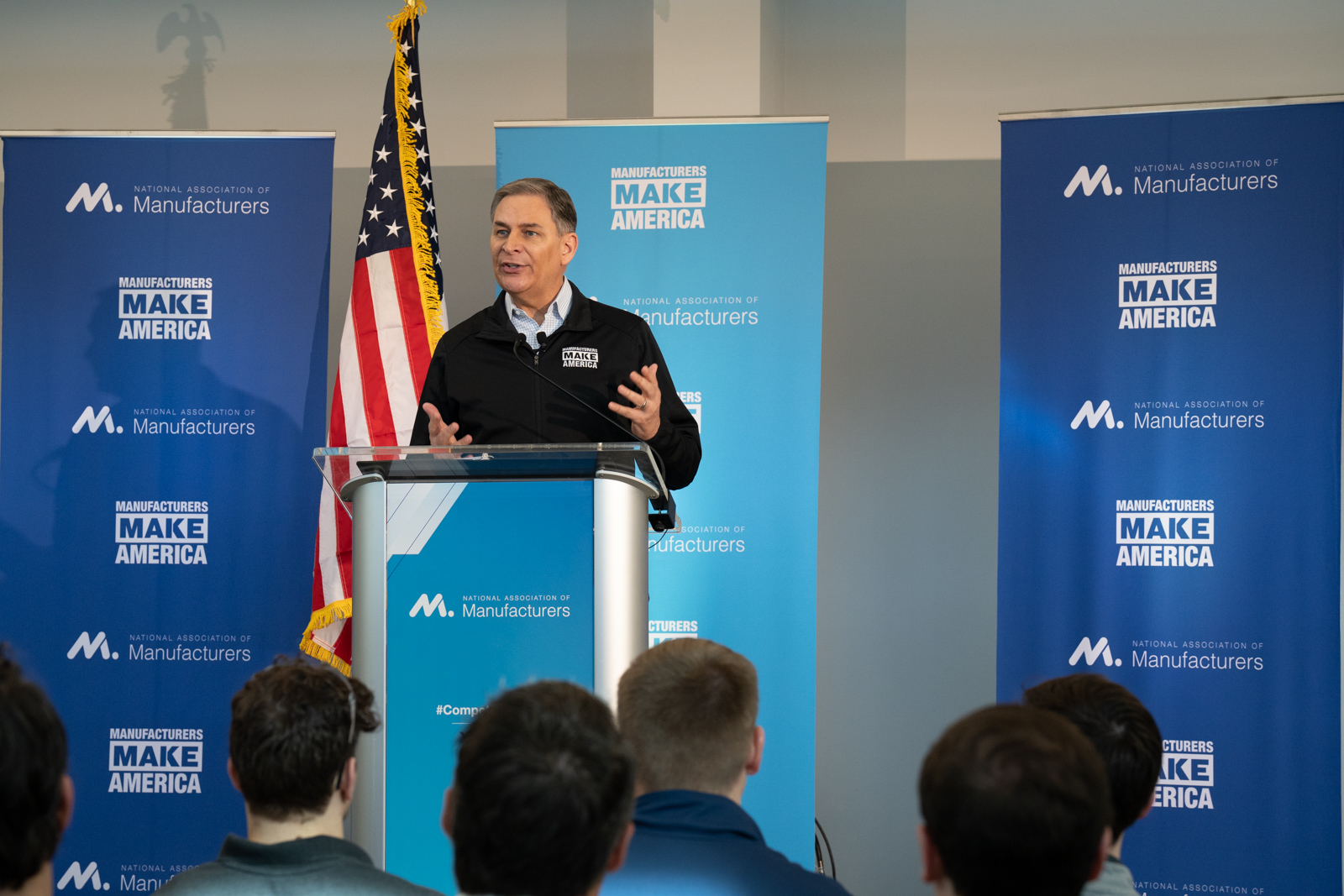
Manufacturing has a leading role in the U.S. economy—but there is still a great deal more to do. That was the message at this year’s NAM State of Manufacturing Address from NAM President and CEO Jay Timmons.
Timmons spoke to a gathering of manufacturing team members and the media at Husco in Waukesha, Wisconsin. In his remarks, he laid out the NAM’s view of where the industry is and where it’s going.
The program: The event began with a message from Kurt Bauer, president and CEO of Wisconsin Manufacturers & Commerce, followed by an introduction from NAM board member Austin Ramirez, president and CEO of global engineering and manufacturing company Husco.
- “Wisconsin manufacturers contribute to the vitality of our state through their innovation, productivity and commitment to customer satisfaction,” said Bauer. “While we face many challenges, we are also in the enviable position of controlling our destiny—as long as we work together to create a shared vision of prosperity and an action plan to achieve it.”
- “We are here to shine a light on the amazing, life-changing work that manufacturers do every day,” said Ramirez. “We are the backbone of the American economy, and we are proud of it.”
The state of manufacturing: Timmons spoke about Russia’s invasion of Ukraine, the importance of the manufacturing industry’s support for the Ukrainian people and the larger struggle between freedom and tyranny.
- “Despite everything happening around us, like the threat of a recession and global conflict, manufacturers are still leading the way forward,” said Timmons.
- “And although our industry and our country will need to make audacious and sometimes uncomfortable changes to adapt to economic, political and global challenges … I’m confident in reporting that the state of manufacturing in America remains steadfast and resolute.”
Manufacturing solutions: Timmons cited a variety of manufacturing challenges, then detailed the NAM’s plans to fight for manufacturers across the United States.
- Supporting immigration: “For so many manufacturers in America right now, there are more open jobs than there are people to fill them,” said Timmons. “One of the many ways we fill those jobs and keep our economy moving is welcoming immigrants into our workforce … just like we have in the past to build a stronger, more prosperous America.”
- Promoting permitting reform: “Permitting reform means making it easier to get permission to build that new road or power plant, or for manufacturers to build new facilities,” said Timmons. “If Washington could just cut through the bureaucracy and streamline processes, like you do in your businesses every single day, we could do more for this country.”
- Fighting for tax fixes: “The NAM is determined to get Congress to restore incentives for R&D and get our business tax rates and structure back on track to enable us to compete globally,” he said. “And then, let’s lock in competitive rates for small businesses … so that you can plan confidently for the future.”
- Competing with China: “If we’re going to counter China, then we must hold China accountable for the trade commitments it has already made to the U.S.,” said Timmons. “And we have to forge ambitious, cutting-edge trade agreements with our allies. Other countries aren’t waiting around. So, let’s think big. And let’s be bold.”
- Pushing back on new EPA rules: “We’re going to tell the EPA that manufacturers are already leading [in cleaning] our air,” said Timmons. “The government shouldn’t enact rules that, however well-intentioned, would make it more difficult to achieve our environmental goals, slow our economic growth and push us closer toward recession.”
The last word: “History shows us that as long as manufacturers lead the way, America and our democracy will remain that beacon of freedom and hope for people around the world,” said Timmons. “Manufacturers have been, and always will be, in word and deed, the arsenal of democracy. And working together, I know we will keep making this a manufacturing decade.”
Timmons: Biden’s Visit Shows the World That the U.S. Stands with the Ukrainian People
Washington, D.C. – National Association of Manufacturers President and CEO Jay Timmons released the following statement on President Biden’s visit to Ukraine:
“President Biden’s visit to Ukraine the week of the anniversary of Russia’s brutal and unprovoked invasion shows the world that the United States stands with the Ukrainian people and that our support is unwavering.
“The struggle in Ukraine is more than a war between two countries. It’s a struggle between freedom and tyranny. Manufacturers believe that there are two systems evolving in this world—one that enriches lives and lifts people up into freedom and prosperity, and the other that is oppressive and robs people of their liberty. We must continue to support the Ukrainian people, ensuring that critical supplies keep moving and investing in and rebuilding this war-torn country.
“Manufacturers in the U.S. have a long and proud history of standing firm in support of democracy, the rule of law, transparency, freedom and opportunity. The NAM and our members have demonstrated our unwavering support for Ukraine and its people, and the NAM spoke out firmly against the war with our Board of Directors passing unanimously a resolution at our meeting in March 2022. We supported sanctions against Russia, called for the suspension of Permanent Normal Trade Relations with Russia and mobilized humanitarian relief to Ukraine. Additionally, the NAM’s Emergency Response Committee has worked with NAM members and Project HOPE to support the resettlement of Ukrainians in the U.S. As an industry, we are committed to working with our partners to ensure that the Ukrainian people have the support they need to build a future of freedom and prosperity.”
-NAM-
The National Association of Manufacturers is the largest manufacturing association in the United States, representing small and large manufacturers in every industrial sector and in all 50 states. Manufacturing employs nearly 13 million men and women, contributes $2.81 trillion to the U.S. economy annually and accounts for 55% of private-sector research and development. The NAM is the powerful voice of the manufacturing community and the leading advocate for a policy agenda that helps manufacturers compete in the global economy and create jobs across the United States. For more information about the NAM or to follow us on Twitter and Facebook, please visit www.nam.org
